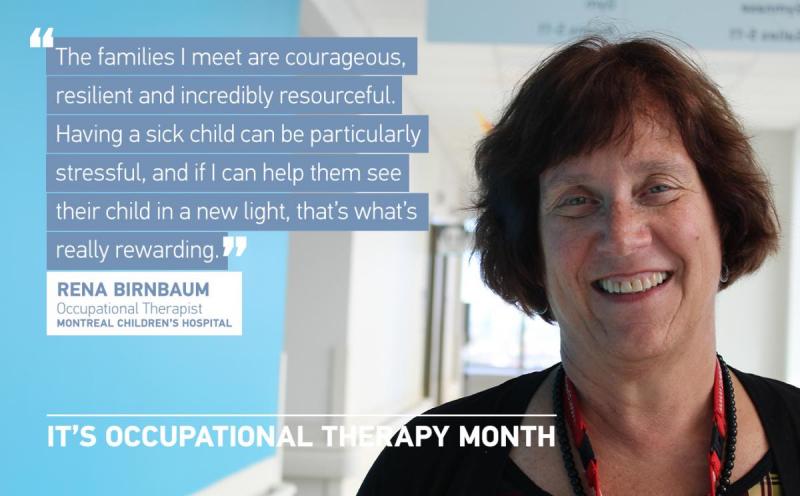Maximizing potential, one patient at a time
October is Occupational Therapy Month

“There’s always something to learn and I feel incredibly valued, not only by the families I meet, but by the team I work with,” says Rena Birnbaum, who has lent her expertise to helping patients and families at the Montreal Children’s Hospital (MCH) since 1981.
Though she has a great deal of experience working with pediatric patients of all ages, Rena also spent a few years working with adult patients earlier in her career. “I like working with adults too, but I’ve always kept coming back to my base at the Children’s,” she says with a smile.
For the last few years, Rena has worked mainly with premature babies and infants who have feeding or swallowing problems in a number of clinics throughout the hospital. Her goal is threefold: to monitor and optimize their development, to ensure safety of swallow, and to help families adapt their environment to the needs of their child.
Her role necessitates a great deal of interaction with parents, an aspect of her work that she finds particularly gratifying given the challenges that many of them face. “I find them to be courageous, resilient and incredibly resourceful,” she says. “Having a sick child can be stressful, and if I can help them see their child in a new light, that’s what’s really rewarding.”
Outside of work, Rena likes to keep active. During the summer months, she can be found dragon boat racing twice a week and year-round she is the proud grandmother of 4 adorable grandchildren.

“Being an occupational therapist requires me to be creative in finding unique solutions to help rehabilitate patients,” explains Christine Tremblay, an Occupational Therapist who has spent the last 25 years working with patients and families at the Montreal Children’s Hospital. For the past few years, she has worked mainly with plastic surgery patients as well as patients born with arm paralysis at birth. Her favourite part of her role, she says, is working with both a team of experts who value her specialty as well as with families. “I am constantly learning and gaining new experience, which provides a great deal of variety to my work,” she explains.
Since her patients are usually quite young, Christine uses toys and games to evaluate motor skills and evaluate development based on what we might usually expect in children of a certain age. In school-aged children, she will work with other specialists in the team to better understand what barriers might be getting in the way of a patient being able to succeed at school. “Working with young patients with the goal of maximizing their potential allows me to provide a lot of hope to families,” she explains. “Seeing improvements and being able to witness parents’ reactions to the changes in their child. It’s almost as though they don’t want the session to finish!”


